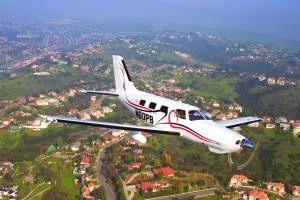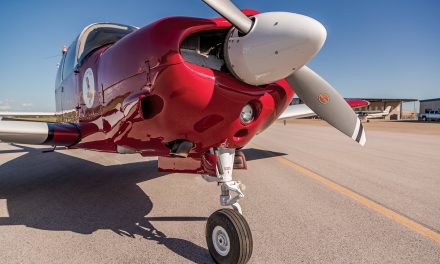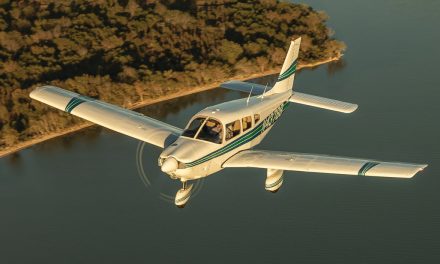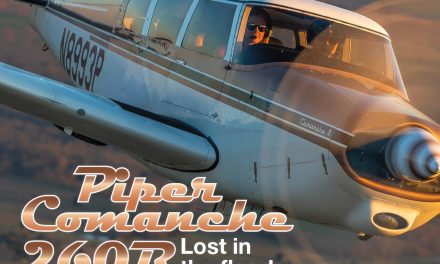 Featured Plane
Featured Plane
Piper Malibu 310
The Price & Pleasures of Pressurization
Pressurization is perhaps aviation’s ultimate creature comfort.
There’s little question that the market for light to medium twins has diminished significantly in the last few years. As this is written, only three piston twins remain in U.S. production – Piper’s Seminole and Seneca V and Beech’s G58 Baron. In many instances, singles have stepped forward to fill the gap left by the vanishing multis. Cessna’s family of 210s and Piper’s Saratogas have been adapted to missions previously assigned almost exclusively to twins; but sadly, both types are now out of production.
To make big singles even more attractive to prospective twin buyers, two companies made the move to pressurization. Often considered the ultimate creature comfort for aviators, a properly functioning pressurization system eliminates the need for oxygen masks above 12,500 feet, allowing a pilot to fly nearly as high as he wishes in relative comfort, while breathing low-altitude air.
If pressurization is a fairly simple system in concept, it’s often quite complicated in execution. Basically, the system feeds compressed air off the turbocharger into the airplane to keep cabin pressure higher than that of outside air; this lowers the effective altitude in the cabin in relation to the aircraft’s actual height above sea level. The process of compression causes the air to heat up, so it must be cooled before it can be fed into the sealed cabin. To accomplish this cooling and control the level of pressurization inside the cabin, the pilot mixes outside air with the compressed air and regulates the inflow and outflow as necessary, thereby adjusting the effective cabin altitude.
Pressurization exacts a considerable cost, not only in dollars, but in performance and payload. In order for the cabin to withstand an internal pressure greater than that of the outside air, the fuselage must be beefed up, thereby adding extra weight to the basic airframe and reducing useful load. Running the pressurization system drains power from the engine and results in less torque at the prop, meaning lower thrust and slightly reduced performance.
Although Mooney had a brief, unsuccessful flirtation with an inflatable airplane (the M22 Mustang) in the ‘60s, Cessna’s P210 was the first model to adapt an existing basic airframe to pressurization for the singles crowd. It’s interesting to compare the first P210 with the derivative T210. Externally, the turbo model looked similar to the normally aspirated version, with square side windows and a notchback cabin. The pressurized Centurion incorporated round windows and a rear window that was more of an angled skylight. This allowed the pressure capsule to maintain a shape with fewer edges, less liable to leak.
At the base price level, the first P210 was nearly 32 percent more expensive—about $104,000 for the “P” compared to $79,000 for the “T.” Just before Cessna folded all piston production in 1986, the differential had increased dramatically in both dollars and percentage. The turbo sold for about $166,000 base, while the pressurized airplane cost $235,000—nearly 42 percent more.
Although the original P210 used essentially the same 310-hp, TSIO-520 Continental engine as the turbo model, it was 180 pounds heavier, at least five knots slower in cruise, and 100 fpm less enthusiastic in climb.
Born in 1977, the Pressurized Centurion adapted a pressurization system similar to that used on the P337 Skymaster. Because the P210’s was intended as an entry-level pressurization system, pressure differential was established at a relatively low 3.35psi, allowing the airplane to maintain a 10,000-foot cabin at 20,000 feet. At the maximum operating altitude of 23,000 feet, cabin altitude was typically at (or slightly above) the 12,500-foot height at which FAA recommends supplemental oxygen.
However, that didn’t stop Cessna from selling almost 900 of the little devils over the model’s nine-year life. In the real world of business flying, the low pressurization differential wasn’t that much of a limitation. For most owners, FL200 was just fine as a maximum, operational altitude. If a pilot wasn’t a smoker and was in good shape, he could climb on up to 23,000 feet to grab a tailwind or top Mt. McKinley. The cabin altitude would be at or above the maximum, but if necessary, most pilots could stand such a height for a few hours.
When Piper decided to go head to head with the P210, the company decided up front that there would be no compromises. Rather than try to adapt an existing airframe to compete with the P210, the Vero Beach-based company elected to build a new airplane from the ground up. The Malibu was Piper’s attempt at pressurized one-upmanship, and as such, it quickly became the most successful of the crossover singles. Who would have guessed that when Piper introduced the world’s first $300,000, single-engine airplane that it would eventually be vying for top sales honors among all airplanes, single or twin? Amazing as it may seem, the Malibu soon became second only to Mooney’s 252 in sales, outselling even Piper’s own less-than-$100,000 Warrior and Archer, Aerospatiale’s gull-wing Tobago and Trinidad, and even the ever-popular Mooney 201LM and 205 combined.
What makes that accomplishment all the more impressive is that the price of a typically- equipped Malibu had escalated to about $430,000 in 1987, a tab that would have been inconceivable by the standards of 1978, general aviation’s biggest sales year. In ’78, the most expensive single-engine airplane available was predictably the aforementioned Cessna P210, priced at about $125,000 fully equipped.
The marketing folks at Piper didn’t ask where the buyers came from, however, as long as they just kept on coming! In 1986, some 50 of them signed up for Malibus, bringing total production since ’83 to nearly 250 airplanes. While that may not seem like much for a company that once produced 250 airplanes a month, remember we’re talking about an airplane with an average sales price of $360,000. That’s a nice round $90,000,000 in total sales.
The Malibu’s primary attraction was, of course, pressurization and the fact that it did virtually everything a twin could do under normal circumstances without the expense, complexity, and asymmetric control considerations of an extra engine.
To illustrate just what a pressurized cabin can do behind a single engine, I took a short trip in an ’87 model Malibu and contrasted that with the same trip in a Cessna 340, about the least expensive pressurized twin readily available on the used market.
Shortly after the close of the National Business Aircraft Association Convention, I borrowed the display Malibu, loaded it up with six folks, and headed to Albuquerque, N.M. for lunch. If that seems a long way to go just to check the local airport chili, the real point was to examine the relative merits of pressurized singles versus more conventional business twins.
Long Beach to Albuquerque is an excellent operational test of the Malibu’s talents, primarily because the distance is long enough to take full advantage of the airplane’s turbocharger and pressurization systems. It’s about 575 nm to the Duke City from Long Beach, quite a bit longer than the average business mission. (Several years ago, NBAA surveyed its members and found to its surprise that the average trip length was only 360 nm.)
Another advantage of choosing the LGB-ABQ hop to test the Malibu’s flexibility was that I could load the airplane with six people and still have plenty of fuel reserve. Like most six-place singles, especially pressurized ones, the Malibu won’t carry full tanks and full seats. The test airplane had a full-fuel payload of more than 650 pounds. Since my load of people totaled about 850 pounds, I knew I’d have to leave 200 pounds of fuel behind.
Fortunately, on the Malibu, that didn’t pose a problem. Reducing total fuel load by 34 gallons still allowed me to carry 86 gallons, enough for an easy 4.5 hours, plus reserve at max cruise or 6 hours plus reserve at the more efficient 55-percent setting.
On my flight eastbound, I also benefitted from prevailing winds. Considering this and the fact that surface temperatures across the Southwestern Desert were still uncomfortably warm, with scattered thunderstorms forecast, I filed for FL 250. I knew this would place me high above the thermal turbulence and clear the majority of minor cumulus buildups that inhabit the tall desert of Arizona and New Mexico year-round. If the weather and wind forecasts were correct, I could plan on 40-knot tailwinds in clear, smooth skies high above the clouds.
Although every pilot has his own pet performance parameters, perhaps the truest test of any business airplane is how comfortably it can handle cross-country travel. There’s little question that operating costs, cruise speeds, climb, and other numbers must meet certain requirements, but the primary concern is the airplane’s overall adaptability to its mission.
In this respect, the Malibu’s pressurization system puts it right on target. Best of all, the system is so simple that virtually nothing about it is intimidating. A pilot can manage pressurization as much or as little as he wishes, but most of the time only one adjustment is required. The CABIN PRESS controller must be rotated to 1000 feet above the departure or destination airport elevation, in my case to 6200 feet for Albuquerque. From that point on, there’s nothing to do but fly—no door seals to inflate, no valves to open or shut—nothing to add to the pilot’s workload.
The Malibu’s pressurization differential is 5.5 psi, so we’d climb on up to 25,000 feet while the cabin leveled at 8000 feet. By any measure, the big Piper’s pressurization system is several times more useable than that of the P210 and even some twins, including the aforementioned 340. If flown at the same 25,000-foot altitude, the 340’s 4.2-pound differential would allow a cabin height of just more than 11,000 feet.
Pumping the cabin up to 5.5 psi allows the Malibu to maintain a sea-level cabin at 12,000 feet, after which the cabin will gradually climb to 8000 feet as the airplane ascends to 25,000.
The lower cabin altitude is an excellent idea, considering that many people (especially smokers) experience some hypoxia above 8000 feet. Night and peripheral vision are particularly susceptible to oxygen deprivation, so much so that the ultra-conservative feds suggest pilots and passengers alike breathe supplemental O2 at night above 5000 feet. (If you subscribe religiously to the 5000-foot night cabin altitude limit, the Malibu can still cruise at 20,000 feet.)
Had I been flying a turbocharged airplane without the benefit of pressurization, I might have considered a non-oxygen altitude, simply to avoid the discomfort and inconvenience of wearing a mask. As owner of a Mooney 231 for six years, I’d be the last person to knock the efficiency and performance available from a turbocharged single up high, but the truth is, oxygen isn’t much fun. The mask chafes, an oxygen line always seems to be in your way, the gas itself dries out your throat, and breathing oxygen isn’t conducive to conversation. Business travelers aren’t big fans of oxygen, either. Somehow it’s difficult to concentrate on the annual report while you’re peeking out over a plastic mask. Cannulas are an option, but only to 18,000 feet.
Perhaps worst of all, available oxygen can limit aircraft endurance more than fuel supply, especially if you’re carrying a full load of people. In the Cessna Turbo-Skylane RG, for example, a full 48-cu.ft bottle of oxygen will last four people only two hours. When you run out of O2, you no longer have the option to fly high until you’ve refilled the system, usually at a cost of $30 or more (and then only when you can find it.)
Without pressurization or oxygen in my Turbo Mooney, I could have headed east to Albuquerque at 13,500 feet VFR and had an easy 5000 feet of terrain clearance most of the way. Two major differences, however, would be speed and turbulence. Even if the weather had been VFR, chances are that the ride would have been uncomfortably rough. Then too, I would have had to settle for probably 30 knots less speed at the lower altitude with less turbo advantage and calmer winds.
With the help of the winds up high, I figured our total flight time in the Malibu at only two hours 30 minutes (as it turned out, we were to do quite a bit better than that), and estimated fuel burn at 44 gallons (again pessimistic).
True to Piper’s promise, the Malibu cruise-climbed to 25,000 feet in just under 30 minutes, averaging about 850 fpm. After leveling and setting power at max cruise, I watched the DME gradually count up to 260 knots—a solid 60 knots better than book. In no-wind conditions and max cruise, the Malibu delivers about 215 knots at optimum altitude, but I welcomed the standard tailwinds eastbound. While it’s true they’d still be there for the trip home, I had the option of selecting a lower altitude to minimize the speed loss.
Cruising three to four miles above the mountain west, the ride was not only smoother; it was less busy as well. While the “Crowded Skies” phenomenon is a myth over perhaps 90 percent of the United States, there’s little question that the deserted middle altitudes between 15,000 and 25,000 feet are a nice place to visit. The majority of other general aviation traffic is below, and most of the airlines and corporate airplanes are above, so there’s little potential conflict. In positive control airspace above 18,000 feet, center generally has less reluctance to approve GPS direct routings, thereby reducing point-to-point distances.
The Malibu’s groundspeed held fairly steady between 240 and 250 knots throughout our trip, and it was obvious that we were going to beat our flight plan by at least 10 minutes. We arrived ahead of schedule for an average 248 knots. Fuel burn was only 41.2 gallons
Had we been flying the 340, we probably would have beat the Malibu by three or four minutes, as a healthy 340 trimmed and leaned at optimum altitude will usually manage about 220 knots, five knots better than the Malibu. However, consider what we would have had to pay for those four minutes. Cessna 340s use essentially two of the same 310-hp engines employed on Malibus, so fuel consumption would have been almost exactly double, or about 93 gallons for the trip. It’s true that the 340 offers an extra engine for safety, but most Malibus are equipped with dual vacuum pumps and alternators so system redundancy is almost the same.
Singles also have a natural advantage over twins when it comes to range. The combination of good fuel specifics, big fuel tanks, and clean aerodynamics gives the Malibu the distinction as the longest-ranged production single in the world. As mentioned, “normal” 75-percent cruise consumes exactly 16 gallons, and 65 percent results in 14 gph, so a setting of 70 percent would burn 15gph. That allows seven hours, plus reserve with 120 gallons aboard.
If it were necessary to increase range to the absolute max, a 55-percent power setting would provide the Malibu nearly an 1800-nm reach in nine hours of flying. (Globe Aero, the world’s largest general aviation delivery company in Florida, regularly delivered Malibus to Europe without ferry tanks installed. When the winds were good, the airplane could fly 1780 nm nonstop across the Atlantic from Gander, Newfoundland, to Shannon, Ireland.)
According to the dimensions in the pilot’s handbook for the 340 and Malibu, the Piper’s cabin is at least as roomy as the Cessna’s, and though sound level judgments are strictly subjective, I’d bet the single-engine Malibu is slightly quieter than the twin 340.
This isn’t to knock the 340. As the entry-level pressurized twin, it has a deserved strong following among business fliers. Because 340s have been out of production since 1984, they’re available for prices well below $150,000, and if you fly many of your hours over water or totally inhospitable mountains, a pressurized twin may be the best bet. The price is right, too. Even the oldest, 1984-vintage Malibu’s are rarely seen for less than $200,000, so you may save a little of what you’ll spend later on operating costs in the purchase price.
Such are the comparative costs and pleasures of pressurized singles. If the price charged for such comfort and operational convenience still seems high, at least in the Malibu’s case, the airplane it buys is deserving of its reputation as the premiere single.
Specifications & Performance – 1984 Piper Malibu
All specs and performance numbers are drawn from official sources, often the aircraft flight manual or the manufacturer’s web site. On used aircraft, common sources of information are Jane’s All-The-World’s Aircraft or Aircraft Bluebook Price Digest.
Specifications
Used Price: $220,000
Engine make/model: Cont TSIA-520BE
Horsepower @ altitude: 310 @ SL
Horsepower on takeoff: 310
TBO – hours: 2000
Fuel type: 100LL
Propeller: 3-blade, CS
Landing gear type: Tri/Retr
Gross weight (lbs): 4100
Std. empty weight (lbs): 2460
Useful load – std. (lbs): 1640
Usable fuel – std. (gal/lbs): 120
Payload – full std. fuel (lbs): 920
Wingspan: 43
Overall length: 26’ 5”
Height: 11’ 5”
Power loading (lbs/hp): 13.2
Wheel size: 6.00 x 6
Seating capacity: 6
Cabin doors: 1
Cabin width (in): 48
Cabin height (in): 47
Performance
Cruise speed (kts): 75% 215
Fuel Consumption (gph): 75% 16.5
Best rate of climb, SL (fpm): 1143
Maximum Operating Altitude (ft): 25,000
Stall – Vso (kts): 60
TO ground roll (ft): 1440
TO over 50 ft (ft): 2025
Ldg ground roll (ft): 1070
Ldg over 50 ft (ft): 1800





